#SUMO Subscriptions
Explore tagged Tumblr posts
Text
Essential WooCommerce Subscription Plugins for 2024

The correct subscription plugin can significantly enhance customer experience, automate renewals, and speed up the administration of recurring payments for proprietors of WooCommerce businesses.
Selecting a suitable plugin can improve your company's revenue model whether you're establishing a fresh subscription service or enhancing an already-existing one. We'll analyse the top subscription plugins in this post, looking at their key characteristics, costs, and unique benefits. The purpose of this guidance is to enable you to make an educated decision that fits your unique business needs. Now let's get started!
1. Woo Subscriptions
Woo Subscriptions is perfect for creating reliable streams of income through model subscriptions because it enables businesses to set up automatic payments. Many membership methods for both apparent and virtual goods are made possible by this plugin.
Woo Subscriptions additionally allows companies to send renew alerts to consumers, ensuring that they are informed of their membership status, and links easily with over 25 payment processors.
2. Subscriptions for WooCommerce
You can build and manage subscription plans for your products and services with ease using the Subscriptions for WooCommerce plugin. It even works well for numerous various kinds of businesses. From online classes and online stores to OTT platforms and fitness centres. For your subscription-based things, you can also set up recurring payments for a specific amount of time. In addition, a free trial of this plugin's membership is available. As a result, your customers are aware of what their membership covers. It ensures smooth transaction processes through integrating with payment gateways like PayPal Standard with ease.
3. Prepaid for WooCommerce Subscriptions
The Prepaid for WooCommerce Subscriptions plugin enhances WooCommerce Subscriptions by allowing merchants to offer prepaid plans. This extension is perfect for businesses seeking to provide customers with the option to pay upfront for a subscription period, offering potential cost savings for both parties.
With this plugin, merchants can create multiple prepaid plans for each subscription product. For instance, alongside a standard monthly subscription, they can offer options like a 6-month or annual prepaid plan. This flexibility encourages higher customer commitment and upfront revenue generation.
5. SUMO Subscriptions
Users can create order subscriptions for non-subscription products as well as basic, variable, and group product subscriptions with the SUMO Subscription plugin. It offers customisation with regard to of subscription lengths and choices for renewal.
The flexible payment gateway support provided by this plugin is one of its best features. For manual subscription renewals, it interfaces with any payment gateway that is compliant with WooCommerce. SUMO Subscriptions has incorporated support for renowned gateways like Stripe and PayPal for automatic renewals, ensuring seamless transaction processing.
Wrapping Up!
A few of the best WooCommerce store-specific Custom Order Status plugins were looked at. The features of these plugins differ; certain ones provide bulk editing options and a limitless ability for developing customised status updates. Email notifications and reporting tools are typical features. It's essential that you select the plugin that maximises order management and best suits the particular needs of your WooCommerce website.
0 notes
Note
A question before I do the Hacking. Can I still safely transfer my old pokemon from bank to home on a hacked device? Not sure if it requires internet connection, if that changes anything, and the games they're from are physical copies. Actually, can I still connect on hacked 3/2ds? (Sorry if you don't know, I don't know/follow anyone else I could reliably ask)
pokemon data seems to be a thing a lot of people are concerned with (totally understandable, i was too!!!) but unless you're doing some dodgy online game cheating you are absolutely fine to go online. here's a pic of me on pokebank on my hacked 2ds if it makes you feel better! (connected to my ultra moon cartridge)

#(and even with dodgy cheating i wonder if ninty's even cracking down on pkhex anymore... like... have you SEEN the gts in xyoras/sumo/usum#it's ridiculous)#well anyway i can't personally check on the Connection to home i do not have a home subscription#but i don't see why there would be any issue at all#bri talks#don't be sorry!!! you guys are absolutely free to send me concerns before you hack#i understand a tumblr anon might be less intimidating to send than joining a massive support server
13 notes
·
View notes
Text






























Things Runway rejected, or was just shit at (I'm starting to suspect the moderation warning means nothing, but don't take my word for it, it's still a fucking expensive subscription to get banned from, I was just being silly with the last few days of it and had little to lose.) There's a lot of waving because I was using "doing pushups" to get them on the floor, but quite often it would give them extra-long arms to actually reach, so telling it to do something else with the hands helped a little there. It's fairly cursed, but if you want to play with it the last extremely Frankensteiny prompt I used was: 1997 sideview rodeo setting color photo from side wrestling pin move on opponent,rugged Tunisian sumo wrestlers plaid shirt and jeans25 Year old spherical english man,cool hair, massively smooth overweight,fallen face down,he has a extremely large round and wide belly. his big belly is hanging down in front of him.he has fallen onto his stomach is smoothly round and he looks pregnant.strained grin expression at camera doing pushups,piggyback,handsomepinning his fat opponent
136 notes
·
View notes
Note
What was the inspiration behind pkmn-monochrome may I ask?
ough. what a good question. i feel like i've been asked this before, but i can finally dive deep into it now that The Reveal is out.
the inspiration for pokemon monochrome was… myself, really.
cody was even initially designed as a sona to represent myself - but eventually i wanted to give them a backstory that solidified them as their own character and give myself an excuse to draw them more, so i created pkmn-monochrome on a whim to make up the lore as i went along. but there were always two things about cody that i had solidified, even back in the beginning: cody was the hacker all along, and was secretly pretending not to be- and they were haunted by the ghosts of their three pokemon, each representing both the gen 1 games and cody's own feelings.
there are a lot of facets of cody's backstory that were directly inspired by my own feelings/experiences with pokemon. or rather- my slow, painful, and messy breakup with modern-era pokemon games.
pokemon is (and probably always will be) my special interest, but i gradually became really disenchanted with the games over time. i think the rot started with the 3DS games (XY played it too safe/basic and felt too small, ORAS was too easy and cut out emerald-exclusive content, SUMO was a good story but too hand-holdy, and then USUM was a cheap re-skin that took too long to get to the interesting parts & ruined the story that made SUMO good). USUM was the last pokemon game i ever bought, because i wasn't impressed with what i was seeing for the upcoming switch games at the time. let's go was a tie-in to a mobile game that i never liked in the first place, SWSH looked underbaked and was cutting out the national dex for the first time ever (and selling SOME of the missing pokemon back to you through expensive DLCs). they created pokemon home, which was the straw that broke the numel's back for me - i didn't want to pay for a subscription service just to keep all of my beloved childhood memories in one safe place. there was a time where all you needed to transfer pokemon was hardware, and that option was being ripped away from me.
it was around that time that i really struggled to cut modern pokemon out of my life. i know it sounds dramatic, but i really do think a part of myself died back then, and i felt a huge grief for losing it- for knowing that if i continued to love pokemon, i would get left behind by the folks who still buy these games that i felt were rushed, unsatisfying, and had predatory business practices. i no longer wanted to be one of those snobby pokemon fans that said "oh, well, even if you criticize it, you're still going to buy it anyway." i couldn't see things the way they did anymore, i couldn't just say, "this game has its problems but i like playing it anyway." i just felt empty.
so like cody, i attempted to make a kanto-centric rom hack, trying to sort out those feelings. the project fell through very early on because i don't actually know how to make a rom hack, but those old ideas were eventually recycled into what became modern day pkmn-monochrome.
but don't get it twisted - just because cody's backstory was directly inspired by my own experiences, that does not make cody a 1-to-1 reflection of me as a person. to me, cody is like a dark, twisted, bad timeline version of me where i never figured out how to healthily sort through my feelings, and instead let them consume me, choosing to take my pain and rage out on others. cody is a very unhealthy person whose actions should not be glorified or imitated. but that's what's so raw and real to me about cody as a character - those feelings could happen to anyone. what's important is what you do in reaction to those feelings. you can't control your emotions, but you can control is your actions. you can't blame your emotions as the reason you hurt people - just as cody can't blame pokemon for the reason they lashed out at red/leaf, their pokemon, and all of the players who unconditionally loved and trusted cody.
monochrome was made for me to sort out my own twisted feelings - sort of like how cody made their rom hack in the first place. but i think it's a lot more healthy for me than it was for cody. because unlike cody, i do still like pokemon - i'm okay with being stuck in the past, loving the older games and not the new ones. it doesn't make me any less of a pokemon fan, and i've found friends out there who feel the same way. i hope the story can help people in the same way it's helped me - identifying my own toxic behaviors and how to avoid them. i hope people can learn from cody's example of what kind of person they shouldn't be.
thanks for the question! i know it's a deeply personal answer, but monochrome is a very deeply personal story to me, haha.
22 notes
·
View notes
Text
AppSumo is a popular platform that offers lifetime deals on software, tools, and services for entrepreneurs, startups, and small businesses. It aims to provide users with significant savings on products that can enhance productivity, marketing, management, and various other business operations. Below is a detailed review of AppSumo's features and functionalities:
Key Features Lifetime Deals:
Discounted Software: AppSumo provides exclusive lifetime deals on a wide range of software products, often at a fraction of the regular price. This allows businesses to access premium tools without recurring costs. Variety of Categories: Deals span multiple categories, including marketing, sales, productivity, web development, design, and more. Curated Selection:
Expert Vetting: AppSumo’s team carefully curates and vets each deal to ensure quality and relevance for its user base. This helps users trust that the products offered are valuable and reliable. User Reviews and Ratings: Each product listing includes user reviews and ratings, providing insights from other entrepreneurs who have used the tools. Sumo-lings Community:
Active Community: Users, known as Sumo-lings, can engage with each other through comments, forums, and social media, sharing tips and experiences about the deals and tools they use. Feedback Mechanism: The community feedback helps AppSumo and product creators improve their offerings and address any issues promptly. Educational Resources:
Webinars and Tutorials: AppSumo often hosts webinars, tutorials, and live demos with product creators, helping users understand how to get the most out of the tools they purchase. Blog and Guides: The platform’s blog offers valuable content on entrepreneurship, growth strategies, and best practices for using various software tools. Refund Policy:
Generous Refunds: AppSumo offers a 60-day refund policy on most deals, allowing users to try out products with minimal risk. If the tool doesn’t meet their needs, they can get a full refund within this period.
AppSumo Plus Membership:
Exclusive Benefits: For a yearly fee, AppSumo Plus members get additional discounts, early access to deals, and other exclusive benefits, enhancing the overall value of the platform. Partner Program:
Affiliate Opportunities: Users can earn commissions by promoting AppSumo deals through its partner program, providing an additional income stream for entrepreneurs and influencers.
Pros Significant Savings: The primary advantage of AppSumo is the potential for significant savings on high-quality software, making premium tools accessible to small businesses and startups. Wide Range of Tools: The platform offers deals across various categories, catering to diverse business needs and helping users find tools for multiple aspects of their operations. Risk-Free Trials: The 60-day refund policy ensures that users can test products without the fear of losing money if the tools don’t work out for them. Community and Support: An active community and comprehensive educational resources help users make informed decisions and maximize the value of their purchases. Curated Quality: The expert vetting process ensures that only valuable and reliable products are featured, reducing the risk associated with purchasing lesser-known software.
Cons Limited Availability: Deals are often available for a limited time, which means users need to act quickly to take advantage of them. This can sometimes lead to impulsive buying decisions. Variable Product Quality: While AppSumo vets its deals, the quality and usefulness of products can still vary, and some tools may not meet every user’s expectations. Subscription Costs: Although the deals are discounted, some users might find the cost of the AppSumo Plus membership and the deals themselves to be a significant upfront investment.
AppSumo is a valuable platform for entrepreneurs, startups, and small businesses looking to access premium software tools at discounted prices. Its curated selection, significant savings, and supportive community make it a go-to resource for finding and utilizing business software. While there are considerations regarding the limited availability of deals and variable product quality, the overall benefits, including the risk-free trial period and wide range of tools, make AppSumo a highly beneficial platform for business growth and efficiency.
5 notes
·
View notes
Text
This Is The Most ICONIC American Motorcycle Ever Made https://themotorbikechannel.com/wp-content/uploads/2024/12/1735286415_maxresdefault.jpg Source: This Is The Most ICONIC American Motorcycle Ever Made by Spite’s Corner. Please don’t forget to give the Video a “Like” on Youtube and subscribe to the channel! Thanks to AG1 for sponsoring the video. Click https://drinkag1.com/spitescorner to get $20 off your first subscription Support the channel and get early access to videos: https://www.patreon.com/spitescorner […] #650 #690 #beginner #davidson #harley #kawasaki #klr #klr650 #ktm #Motorcycle #noob #scmr #smc #smcr #smcr #spike #spite #spitescorner #spitescorner #sumo #supermoto https://themotorbikechannel.com/this-is-the-most-iconic-american-motorcycle-ever-made/?feed_id=28310&_unique_id=676e5ec88cb7d
0 notes
Text
Sumo Affiliates Pro WordPress Affiliate Plugin v10.3.0
https://themesfores.com/product/sumo-affiliates-pro-wordpress-affiliate-plugin/ Sumo Affiliates Pro WordPress Affiliate Plugin v10.3.0 SUMO Affiliates Pro is a Comprehensive WordPress Affiliates Plugin using which you can run an affiliate system on your existing WordPress Site. You can award affiliate commissions for actions such as Affiliate signup, Form Submission, Product Purchases, etc. Features Comprehensive WordPress Affiliate Plugin Advanced integration with WooCommerce Affiliate commission for form submission through Contact Form7 Formidable Forms WP Forms Affiliate commission for email subscription through MailChimp ActiveCampaign Affiliate commission for accessing individual pages/posts which has landing commission shortcodes Affiliate registration form for users Users can attach documents while submitting the affiliate registration form Option for the user to directly become an affiliate while creating an account through WooCommerce Users with an existing account on the site can also become as an affiliate When a logged in user tries to become an affiliate, site admin has the option to Manage the affiliate account within the existing account Create a separate account for affiliate promotion Let the user decide Option for the site admin to notify and get notified about the affiliate activities via SMS and Email Separate table for the site admin to manage the affiliates Option for the site admin to automatically approve all the affiliate applications/approve after review Separate dashboard for the affiliate to manage the affiliate promotion Option for the site admin to create unlimited additional tabs in the affiliate dashboard Affiliates can generate unlimited affiliate links QR code can be generated for affiliate links and can be downloaded as an image Affiliate link validity can be restricted to the product for which the link was generated Refer a friend form for affiliates Option for the site admin to create unique landing pages for affiliates The validity of affiliate links can be customized by the site admin Option for the site admin to identify the affiliate based on Affiliate ID Affiliate Name Option for the site admin to allow their affiliates to customize their affiliate slug Option for the site admin to allow affiliates to generate readable affiliate links(Pretty affiliate links) Your Affiliates can promote the products on your site without using an affiliate link MLM system for Affiliates The number of direct referrals, number of levels to award MLM commission and commission rate for each level can be customized Account Signup Affiliate Commission Affiliate Signup Commission WooCommerce Product Purchase Commission Option for the site admin to set commission rate for individual products at the affiliate level Affiliates can receive referral commission when their referrals use the WooCommerce coupons which are linked to them Option for the site admin to award lifetime commission to the affiliates for the purchases made by their referrals Separate table to capture the URLs that were accessed using an affiliate link The Conversion status of the affiliate links will be captured Separate table to capture the referral actions which got converted Option for the site admin to approve the referrals automatically/approve the referrals after review Referral commissions can be restricted for specific products/categories Option for the site admin to stop awarding the commission to the affiliate if The referred user has exceeded the number of orders specified The referred user has exceeded the amount to be spent on the site The referred user has exceeded the amount to be spent on one order Option for the site admin to allow their users to select an affiliate during checkout, so that the affiliate commission for that purchase will be awarded to that affiliate Option for the site admin to allow their affiliates to view the order details of their referrals Option for the site admin to earn commissions for the purchases made using their own affiliate links When a user uses multiple affiliate links to complete a referral action, site admin has the option to Award commission for the first affiliate Award commission for the most recent affiliate Option for the site admin to set a maximum commission amount which can be allowed for any referral action Site admin can process referral payment for their affiliates using any one of the payment methods listed below PayPal Payouts Bank Transfer Affiliate Wallet Reward Points(Requires SUMO Reward Points) Option for the site admin to attach files in the emails sent to the affiliates Option for the site admin to automatically generate and send payout statements as a PDF file in the payout emails Option for the site admin and affiliate to be notified via pushover notification for referral actions Option for the site admin to display a leaderboard of the affiliates Option for the site admin and the affiliate to view detailed reports about affiliate promotion on the site Option for the site admin to send periodic reports via email to their affiliates Option for the site admin to export the following data as CSV Affiliates Visits Referrals Payouts Option for the site admin to create promotional banners which can be used by affiliates for promoting the site Compatible with SUMO Reward Points Affiliate commissions can be awarded as Reward Points(Requires SUMO Reward Points Plugin) Compatible with SUMO Subscriptions Option for the site admin to award affiliate commission for Only initial payments Both initial and renewal payments Compatible with SUMO Payment Plans Payment plan product s affiliate commission will be awarded once the final payment for the product has been received Compatible with SUMO Pre-Orders Option for the site admin to award commission for Pay Upfront products Pay on Release products Highly customizable Extensive list of shortcodes Translation ready and more SUMO Affiliates Pro – WordPress Affiliate Plugin Please note that any digital products presented on this website do not contain malicious code, viruses or advertising. https://themesfores.com/product/sumo-affiliates-pro-wordpress-affiliate-plugin/ #AffiliatePlugin #WordpressPlugins
0 notes
Text

30 Essential Image Editing Tools to Elevate Your Visual Content
In the digital age, images are a crucial part of communication, whether it's for personal expression, branding, or storytelling. With the plethora of tools available online, anyone can become a visual artist. Here's a comprehensive list of 30 tools that can help you create and edit images to perfection.
Adobe Photoshop: The industry-standard software for photo editing and manipulation.
GIMP: A free and open-source alternative to Photoshop with many similar features.
Canva: An online design tool perfect for creating social media graphics, presentations, posters, and other visual content.
Pixlr: Offers a suite of cloud-based image tools and utilities, including a photo editor and a design tool.
Figma: A vector graphics editor and prototyping tool which is web-based.
Sketch: A digital design toolkit for app, web, and interface design.
Affinity Photo: A professional photo editing software with a one-time purchase.
CorelDRAW: A graphic design software used for vector illustration and page layout.
Paint.NET: A freeware graphics editor program for Microsoft Windows, developed on the .NET Framework.
Inkscape: An open-source vector graphics editor similar to Adobe Illustrator, CorelDRAW, and Xara X.
Adobe Illustrator: A vector graphics editor and design program, widely used by graphic designers.
Gravit Designer: A full-featured vector graphic design app that works on all platforms.
PicMonkey: An online photo editing and design service that can be accessed from a web browser, or through a mobile app.
Snappa: Allows you to create online graphics in a snap with its drag-and-drop interface.
Crello: A visual editor designed for creating social media images, ad banners, posters, email headers, and other popular formats.
Vectr: A free graphics software used to create vector graphics easily and intuitively.
Lunapic: An online photo editor with several unique animated effects.
BeFunky: A user-friendly photo editor that offers an array of tools for photo editing and graphic design.
Visme: A tool for creating presentations, infographics, social media graphics, and more.
DesignBold: An online design tool for making designs in just a few clicks.
Krita: A professional, free and open-source painting program designed for digital artists.
Sumo Paint: A browser-based image editor, with all the standard features you would expect from desktop software.
Blender: An open-source 3D creation suite that supports the entirety of the 3D pipeline.
Daz 3D: A 3D scene creation and rendering application used to produce images as well as video.
Clip Studio Paint: For drawing and painting, used by artists for creating comics, illustrations, and animations.
Photopea: An advanced image editor, which can work with both raster and vector graphics.
Pablo by Buffer: A simple online design tool to create social media images quickly.
RelayThat: Helps in creating branded designs for multiple platforms at once.
Tinkercad: An easy-to-use app for 3D design, electronics, and coding.
Autodesk SketchBook: A drawing and painting solution for creative professionals, including architects and designers.
With these tools at your disposal, you can unleash your creativity and bring your ideas to life. Whether you're a professional designer or a hobbyist, there's something for everyone in this list. Dive in and explore the possibilities!
Remember, while some of these tools are free, others may require a subscription or purchase. Always choose the tool that best fits your needs and budget. Happy designing!
0 notes
Text
How to Add Pop-Up Forms to Your Website: A Beginner's Guide

Introduction
Pop-up forms have become a staple in the world of web design and online marketing. They are powerful tools to capture leads, engage visitors, and grow your email list. If you're a beginner wondering how to add pop-up forms to your website, you're in the right place. In this comprehensive guide, we'll walk you through the process step by step.
Understanding Pop-Up Forms
What Are Pop-Up Forms?
Pop-up forms are overlays or windows that appear on a website, typically designed to capture visitor information, such as email addresses or contact details. They can serve various purposes, including email list building, promoting special offers, highlighting newsletter subscriptions, and more.
Why Are Pop-Up Forms Important?
Pop-up forms are valuable tools for website owners and marketers for several reasons:
Lead Generation: They help collect valuable leads for email marketing campaigns.
Engagement: They capture the visitor's attention, increasing engagement.
Conversions: When used effectively, they can boost conversion rates for specific goals.
User Experience: Modern pop-up forms can be less intrusive and offer a better user experience compared to traditional pop-ups.
Choosing the Right Pop-Up Form Type
Before diving into adding pop-up forms to your website, it's essential to understand the various types available and when to use them.
Entry Pop-Ups
These pop-ups appear immediately when a user lands on a page. They can be effective for promoting time-sensitive offers or capturing attention right away.
Exit-Intent Pop-Ups
Exit-intent pop-ups detect when a visitor is about to leave your site and display a message or offer in a last-ditch effort to retain them.
Timed Pop-Ups
Timed pop-ups are triggered after a specific duration of time spent on a page. They can be useful for showcasing newsletter sign-ups or highlighting a featured product.
Scroll-Triggered Pop-Ups
These pop-ups appear when a visitor scrolls down a certain percentage of a page. They are often used for presenting relevant content or offers as the user explores your site.
Selecting a Pop-Up Form Plugin
Choosing the right pop-up form plugin is crucial for a seamless integration process. Here are some popular options:
Popular WordPress Pop-Up Plugins
OptinMonster: Known for its versatility and ease of use, OptinMonster offers a range of pop-up types, targeting options, and integration with email marketing services.
Sumo: Sumo provides a suite of marketing tools, including pop-up forms. It's user-friendly and integrates with various email marketing platforms.
Bloom (by Elegant Themes): Bloom is a WordPress plugin that focuses on email opt-ins and offers customizable pop-up designs.
Non-WordPress Options
If you're not using WordPress, consider standalone pop-up tools like:
Hello Bar: A simple yet effective tool for creating pop ups in elementor and bars.
Mailchimp: Mailchimp offers pop-up forms that integrate seamlessly with their email marketing platform.
Poptin: A versatile pop-up builder suitable for different websites, even if they're not WordPress-based.
Step-by-Step Guide to Adding Pop-Up Forms
1. Installing and Activating Your Chosen Plugin
If you're using WordPress, go to your WordPress dashboard, navigate to "Plugins," and click "Add New." Search for your chosen pop-up plugin, install it, and activate it.
2. Configuring General Settings
Access the settings panel for your chosen plugin and configure basic settings such as the display frequency and animation styles.
3. Creating Your First Pop-Up Form
Most plugins offer pre-designed templates. Select a template that aligns with your goal, and start customizing it.
4. Customizing the Design
Modify the pop-up's appearance, including colors, fonts, images, and form fields. Ensure that the design matches your website's branding.
5. Setting Display Rules
Define when and where the pop-up should appear. You can set rules based on page type, user behavior, or referral sources.
6. Integrating with Email Marketing Services
Connect your pop-up form to your email marketing platform. This step is crucial for automatically adding captured leads to your email list.
7. Testing Your Pop-Up Form
Before going live, thoroughly test your pop-up form to ensure it functions correctly on various devices and browsers.
8. Going Live
Once you're satisfied with your pop-up form's design and functionality, activate it on your website.
Best Practices for Effective Pop-Up Forms
To maximize the impact of your pop-up forms, consider the following best practices:
Timing and Frequency
Be mindful of when and how often pop-ups appear to avoid overwhelming users.
Crafting Compelling Content
Create persuasive and relevant copy and offers that encourage users to take action.
Designing for Mobile Responsiveness
Ensure that your pop-up forms look and function well on mobile devices.
A/B Testing
Continually test different elements of your pop-ups to optimize conversion rates.
Compliance with GDPR and CAN-SPAM
If you collect user data, comply with data protection regulations to maintain user trust.
Conclusion
Adding pop-up forms to your website is an excellent way to engage visitors, capture leads, and drive conversions. By following this beginner's guide and implementing best practices, you can make the most of this valuable tool in your online marketing strategy. Remember to test, analyze, and refine your pop-up forms continually to achieve optimal results and enhance the user experience on your website. Happy pop-up form building!
0 notes
Text
Coloring Apps Market to Observe Strong Growth to Generate Massive Revenue in Coming Years
Latest study released by AMA Research on Global Coloring Apps Market research focuses on latest market trend, opportunities and various future aspects so you can get a variety of ways to maximize your profits. Coloring Apps Market predicted until 2027*. When the rest of the world is going digital, there's no reason for Coloring to be left behind. Hence, welcome to the realm of digital coloring with these new appealing designs. Apps for Coloring The Recolor Coloring app 2022 takes coloring to the next level with its 3 Dimensional Coloring Objects, which deliver a high-quality painting experience. It includes a variety of 3-D templates in addition to the original 2-D patterns, giving a three-dimensional coloring experience. Coloring apps have been around for quite some time. Adults performing them to reduce stress, on the other hand, is a relatively recent concept. In the current situation, it's more or less acceptable for adults and children to use a coloring app. On platforms like IOS and Android, there are a variety of coloring book apps. Many coloring applications claim to be services as well as charge on a weekly, monthly, or yearly membership basis.
Some of Key Players included in Coloring Apps Market are
Recolor (Finland)
Pixite Inc. (United States)
Shapefactory (United kingdom)
Veraxen (Cyprus)
Colorfly (United States)
Sumoing (Finland)
Fabros (Belarus)
Beresnev Games (Czech Republic)
Market Trends: Increasing Awareness Among Consumer Regarding The Benefit Of Coloring Application
Drivers: High Accuracy In Designs With Rate Of Human Error Is Minimal
Increasing Penetration Of Internet
Challenges: Device Compatibility With Coloring Application
Opportunities: Growing Demand From Emerging Economics Market Such As China, India, Brazil, Among Others
The titled segments and Market Data are Break Down by Type (Paint Mandalas, Patterns, Animals, Florals, Thematic Images), Application (Adults, Kids), Platform (PC, Tablet, Smartphone), Subscription Options (Weekly, Monthly, Yearly)Presented By
AMA Research & Media LLP
0 notes
Text
Oh wow! A selfie! Reimu had heard about these before! Aya must have considered her a better friend than she'd thought.

"My best leaves are my only leaves. Unfortunately, I can't afford nice tea. I can't afford much of anything. That's why I can't pay for your subscription, remember?"
When Reimu caught up to Aya she threw her own arm around the woman's shoulder, an attempt to imitate what she thought was a friendly gesture. Seeing the last of her sake in the hands of someone else was disheartening but it seemed fair in return for all the hot gossip she was about to earn. Yet it was the next thing that really caught Reimu's attention.

"Of course I want to hear about kappa wrestling! I love kappa sumo. Learning how to do it is part of learning how to fight youkai you know." Although it's much less useful now that they lack the divots in their heads. "I even heard one of the big bosses of you tengu was something of a sumo champ a few centuries ago. I wonder if the great tengu will come down from the mountain to participate!"
Her eyes were beaming with excitement. How could she have let news like this slip by her? At this point Reimu had already taken a seat at her Kotasu and was gesturing for Aya to sit on the opposite side. After all, she needed to get more kappa wrestling lore immediately.

"Oh? Ohhhhhhh? The dignified and respectable Hakurei Shrine Maiden inviting a lowly Youkai for tea~? How scandalous! I accept, of course." However Reimu may find Aya throwing her arm around her shoulder and snapping a selfie of the two of them just a mite surprising. "Consider this my contingency. Bring out your best leaves~!" With an irritatingly endearing wink, Aya strolls on into the shrine like she owned the place. Shock of shocks, right?
Continuing her trend of hospitality abuse, Aya took it upon herself to nab some snacks and a bottle of cheap sake as well. "To business, then? I doubt you're much interested in the regional Sumo Tournament the Kappa are hosting... You don't strike me as a fan of the sport. What manner of intel would strike your fancy~? Any suspicious ne'er do wells out and about? I could discuss this issue, but if you need any special tips...?"
7 notes
·
View notes
Text
Review: Hotshot Racing
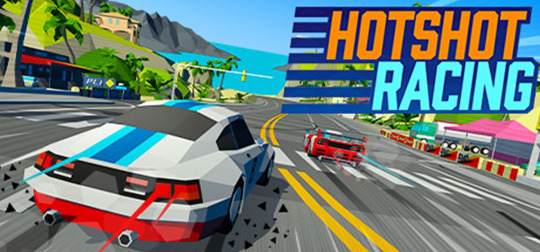
(For this review, Hotshot Racing was played on the Nintendo Switch and the Personal Computer)
If you were to ask me what the most important features of a racing game are, somewhere near the top of the list would be artificial intelligence. Racing games are one of those genres, like fighting games or shooters, where simulating how real human people play the game is vital to the experience. They are inherently multiplayer concepts, even if you’re playing by yourself.
Focus on multiplayer artificial intelligence has waned over the last 15 years. With the rise of the premium multiplayer subscription, it’s more important than ever before to drive players to play matches with flesh-and-blood human beings online. Thus, advancements in “bot” (simulated human player) development hasn’t just slowed down, but in some cases actively regressed. Epic Games, once home to some of the smartest, most robust first person shooter bots in Unreal Tournament, now features bots in their popular Fortnite Battle Royale that fumble around the map with low attention spans and aim like they're blindfolded.

Humans are hard to simulate. The basic functions of a player are easy to emulate -- navigation, aiming, and so on, but it’s the organic logic underneath that proves to be the primary challenge. Humans have lapses in judgement. Humans make mistakes. Mistakes compound on other mistakes. A person wins or loses a given game because of a constantly cascading sequence of decisions, all feeding in to and out of themselves. Whether they realize it or not, every individual person is their own infinite web of chaos. For a computer, which operates in a binary of either perfect success or total failure, no amount of processing power can make for an accurate duplication.
As such, artificial intelligence has to “cheat.” Flaws are introduced into the simulation in order to throw the player a bone. Intelligence almost doesn’t even enter the equation; instead, it’s more about developing a bot that the player simply believes is human, like some kind of a magic trick. It’s a tight balancing act -- if the bot is too good, it looks like an unfeeling terminator. On the opposite, well… compare my Fortnite example up above. There’s a sweet spot that must be hit: smart, but not too smart. Dumb, but not too dumb. It’s easier said than done.
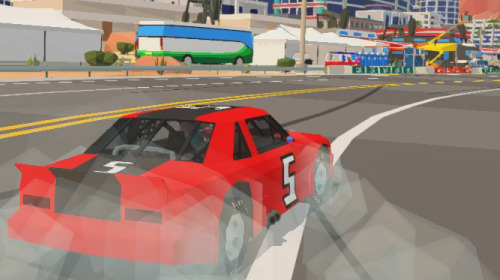
Racing games are a special category here. On top of simulating a human, they must also simulate an automobile, with all of its physical interactions. Tire friction, suspension bounce, weight distribution, and horsepower efficiency just to start. I’d argue that this lends to a much greater tendency for natural mistakes to occur, as the two different simulations (vehicle and player) interact and bounce off of each other. This has led to racing games relying on a handicap known as “rubberbanding.” Essentially, if the player is doing a little too well, the game will start giving tiny advantages to the computer-controlled racer. A boost to top speed, a reduction in weight to improve handling, whatever it takes to ensure the player does not remain unchallenged for very long.
Which finally, at long last, brings us to Hotshot Racing. Developed by Lucky Mountain Games, with assistance by Sumo Digital, it attempts to capitalize on the growing faux-retro-3D trend. It promises visuals to remind you of Sega’s Virtua Racing or Namco’s Ridge Racer, but with decidedly modern vehicle physics and a bit more content than any of those old games could muster.

It honestly makes for a weird first impression. This is a retro-looking game that does not feel like any retro racing game I’ve ever played. Some would undoubtedly argue that’s for the better; like with most sports games, there’s this sense that more simulation is always better. Even modern “arcade” racers like Need for Speed or Wreckfest run pretty robust physics simulations under their hoods, even if they do not necessarily adhere to the rules of reality. But I’ve honestly never seen a problem with this -- I will readily go back to something like Daytona USA or even Stunt Race FX on the Super Nintendo, and never feel especially bothered by their primitive simulations. To me, racing is often more about the sense of speed, how well the controls respond, and the track design than any notion of feeling “realistic.”
That’s not to say it’s really a negative that cars in Hotshot Racing have some vague facsimile of modern weight and “realism” applied to their driving physics, I guess. It’s just something that takes a little bit of getting used to, because seeing these cars drift and sway like the racing games of today is a little anachronistic to the era being called back to. If you still burn a candle for the eventual release of the long-lost Kickstarter darling “90’s Arcade Racer,” know that this isn’t that game. I think it’s fair to say it’s trying to scratch a similar itch, but it’s doing so in a very different way.
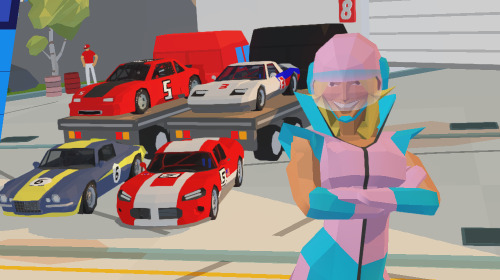
One of the more important things Hotshot Racing brings to the table is a roster of personalities to race as and against. When you think of characters in a racing game, your mind probably more naturally gravitates towards something like Mario Kart or some other similarly kid-friendly cartoon racing franchise. For most "serious" racing games, your opponents are unknowable, faceless competitors, but Hotshot gives them voices and identities. Every character in the game has a garage of four cars unique to them, in addition to having their own story to tell. It’s nothing especially deep; most plot manifests in a single cutscene played at the end of a given grand prix, sort of like what you'd get for finishing arcade mode in a game like Street Fighter 2. It’s just a snippet, a taste of what motivated these people and what they’re going to do after winning, but it’s enough.
It goes back to what I said earlier, and how it’s important for the player to believe the artificial intelligence is more than just a computer. Making the racers into characters, with identifiable personalities, faces, and dialog goes a long way to fleshing things out and makes you connect with what’s going on just a little bit better. Or at least, that’s how things would work in theory.
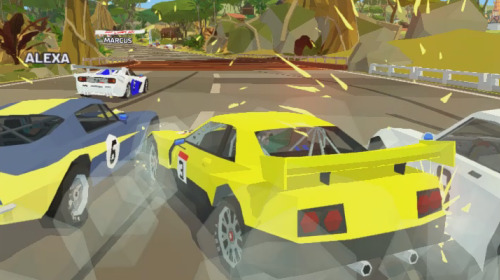
The problem is… well, none of that matters. Put simply, the actual artificial intelligence you race against kind of sucks. In fact, it’s hard to even call them competitors, because your opponents seem to be running a different race where you straight up don’t exist. During any given event, your rival computer drivers seem to be totally blind to your presence, as they will spend the entire race trying to drive straight through you. I don’t know how else to explain it. This isn’t a simple case where the computer drivers are a little aggressive, because they usually aren’t racing to be destructive. They never seem to specifically go out of their way to attack, they just don’t seem to be able to see where you are, and make no effort to react to your presence. You happen to be in their way, so they plow through from behind, ram from the side, and generally just knock you around as if you were invisible.
A side effect to this is something I’ve started noticing in games that bear the Sumo Digital name: computer drivers can hit you way harder than you can hit them back. Whether rubbing against a rival car or engaging in a full-on collision, computer drivers always seem to be able to overpower player vehicles no matter what. In Hotshot Racing, I’ve encountered multiple scenarios where a computer driver shoves me around with little effort, but any attempts to return the favor and my car may as well be made out of styrofoam for how little impact there is. I know Sumo Digital only assisted Lucky Mountain Games on the back half of developing Hotshot Racing, but this has been a consistent element I’ve noticed in Sumo’s Sonic Racing games, too. The computer can be as aggressive (or as blind) as they want, but human players are never allowed to retaliate in a way that feels meaningful.

The worst, by far, is what I mentioned earlier: rubberbanding. “First place” in Hotshot Racing is an often endless war of attrition, where no matter how fast you drive, there are always cars nipping at your heels. Hotshot Racing has a boost system, wherein by drifting or drafting you charge up a segmented meter. Once a segment is full, you can burn it for a burst of speed. I’ve spent 2, 3, even 4 consecutive boosts in a row and the same three opponents were still right behind me, aiming to blindly smash my car out of the way. Hard, medium, or easy mode, it doesn’t matter. They are always there, just a few feet from your rear bumper, magically closing the distance to constantly steal your lead.
From a game design perspective, I understand why rubberbanding exists. It’s to keep the player feeling challenged and engaged. Spending too long in first place going unopposed can start to feel boring. Some game designers view that as a turn off. Races are meant to be battles. At the same time, being able to totally shut out my opponents and gain huge leads makes me feel good. Hotshot Racing robs you of that sense of total domination because of some artificial rule of competitiveness. It’s not that the computer-controlled racers are better than you; they don’t seem to race with any sort of great care or skill. Instead, they catch up and pass you strictly because the Hand of God bends the rules to accommodate them. That doesn’t feel very challenging and it certainly doesn’t feel fair.
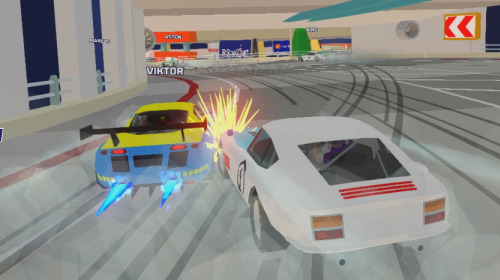
That being said, the pseudo-realistic physics mentioned earlier do have their own downside: I found it a little too easy to lose control of my vehicle and spin out. If you brush against a wall wrong or get bumped by a rival during a drift, you often find yourself in a tailspin and unable to recover. Combined with the blind artificial intelligence and the rubberbanding, you have a recipe for getting frustrated. I want to feel confident in my losses, not because I couldn’t predict what Mr. Magoo was going to do next. To add insult to injury, the rubberbanding only gets more prominent as you move up in difficulty, so expect to get spun out more and more as you progress through the game.
There also isn’t a lot to do with your vehicles, either. For many, tuning is an important aspect of racing games, going all the way back to 1989’s “Super Off Road” in the arcades. No upgrade path is available for any of the vehicles in Hotshot Racing, with a basic unlock system geared towards limited cosmetic tweaks. There's tons of tracks to race on, and you constantly earn currency for winning races, but I never cared about spending any of it, because there wasn't much worth buying. Arguably the specific mid-90′s era that Hotshot Racing is aiming at wasn’t really heavy on upgrading or modifying around vehicle stats, but neither were they focused on visual customization either, so it does feel a little arbitrary what they chose to modernize about this experience and what is intended to be a retro tribute.
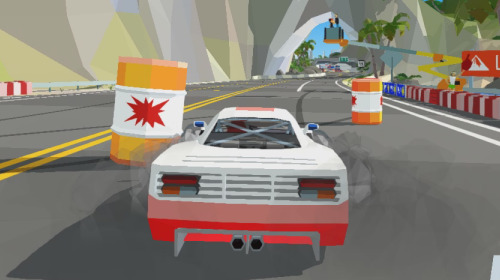
Beyond standard racing, Hotshot does offer a few alternative modes, but none of them are spotlight features. “Barrel Barrage” has you earning an explosive barrel to drop behind you at every checkpoint until the track becomes a minefield. “Drive or Explode” takes the concept of 1994’s “Speed” and straps a bomb to your car that will explode if you slow down for too long. Finally, “Cops & Robbers” is a confusing push-and-pull where you must steal money as a robber and alternatively wreck other racers as a police officer. Of the three modes, “Drive or Explode” is the clear winner, as it most easily fits into the standard three-lap structure the game centers around. “Barrel Barrage” is merely okay, and benefits more from an increased number of laps, as things slowly get more and more dangerous as you progress. These modes would also benefit if I didn’t get thrown back to the menu after every race; they really needed some kind of Grand-Prix-style playlist.
“Cops & Robbers” deserves its own entire paragraph for what a weird idea it is. It’s less about stealing and arresting and has more in common with the “zombie” modes seen in other games, where everyone gets converted to a specific team until there are no more players left. The idea is that you start with a pot of money that slowly depletes, and you have to race to the next checkpoint to cash out. The faster you get there and the higher amounts you cash out with, the more the cops specifically will target you. Once they wreck your car, you become one of the cops, and it’s your job to wreck the remaining robbers until they all become part of the cop team. Once all the robbers become cops, winners are tallied based on who stole the most money. On paper, this works, because it plays into the game’s slap-happy nature, but in practice I would find myself miles ahead of my fellow robbers and once I finally switched over to a cop, I had to slam on my brakes and wait for everyone else to catch up. By then, the computer-controlled cops had usually done most of my work for me and I lost for... being a better robber than a cop, somehow? It left a lot to be desired.
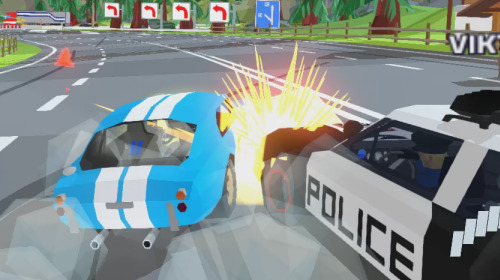
All of these modes can be played online, where presumably human players would make them more balanced and fun, but finding random pick-up games proved difficult in the time I spent with Hotshot Racing. Now, to be fair, I didn’t try especially hard -- racing games have always been a single player experience for me, as should be obvious by my spiel on artificial intelligence. But I did spend a couple nights trying to match into an online “Quick Race” on the Switch, where I universally came up empty handed. On the PC version of Hotshot Racing (which I received as part of a Humble Bundle), the application completely froze upon trying to start a “Quick Race” lobby, forcing me to ALT+F4 to close the game. For what it’s worth, the Switch version does also include a “local multiplayer” option for playing wirelessly with friends in the same room, and all versions support traditional split-screen.
Despite all of these shortcomings, I just can’t bring myself to hate Hotshot Racing, and it’s hard to pinpoint why. I’m definitely in love with this aesthetic -- the retro visuals, the upbeat music, the blue, blue skies (that I see), it all appeals to a certain part of my brain that likes razor-sharp, ultra-clean polygons. The introduction of named racers with backstories and character-specific “endings” is a really smart, fun idea. I just wish it was more fun to actually, like… run a race in this game. I understand the necessity behind concepts like rubberbanding, but it feels like the artificial intelligence cheats just a little too much, and as a player I don’t feel like I can do a lot to fight back. Running a good race isn’t always good enough.

Some games deliberately incite a feeling of disempowerment in their players, and that can be a totally valid design decision. But should that really be the goal of this kind of racing game? I guess I don’t have an answer for that, but I do know that I probably won’t be going back to Hotshot Racing very often.

#writing#review#hotshot racing#lucky mountain games#sumo digital#artificial intelligence#racing apex
10 notes
·
View notes
Note
Norwegian here! I saw you talking about calendars and I just couldn’t stop myself haha
I recommend «The julekalender»! It’s about nisser who speak a mix of English and Norwegian, and it might be useful bc they translate a lot directly which can be helpful to sentence structure and sayings etc. Although it is trøndersk dialect, which might be a little hard.
My aunt is Chinese and she absolutely loves it bc she identifies with the mixing of the two languages! It’s old, classic and cozy. The same three actors play two characters each.
It airs on TV2 Zebra, so you might need a TV2 Sumo subscription though.
Others on NRK: Exit, Kampen om tungtvannet, familien Ingebrigtsen, Helene sjekker inn
Xx
ahhhhh more julekalender!!!
also people??? i’ve been learning norwegian for 4 (??) years how come it’s the first year every one is telling me about this???
9 notes
·
View notes
Text
See It Firsts for 9/4/2020
Apologies for forgetting about this until now, but Cartoon Network does indeed have some See It Firsts today. Only one show, Ben 10 2016, but there’s either 7 or 8 episodes depending on how one looks at the first two parter. Here they are:
Tokyo Fun Part 1: Big Bugg Bash - While in Tokyo, Team Tennyson comes face to face with a horrible secret, Japan's hottest new restaurant is being run by the Bugg Brothers as a nefarious scheme to make loads of money off an unsuspecting public.
Tokyo Fun Part 2: Slamming It Up - While on a visit to the Sumo Slammers Amusement Park in Tokyo, Team Tennyson gets to watch a genuine sumo wrestling match as part of the Global Games, but when the mischievous Twain Twins crash the event to avenge their mother's medal snub years earlier, Ben must think things through if he is to stop the polarizing family!
Growing Up is Hard to Do - Ben and Gwen are stoked to enter a skating competition, but when Nanny Nightmare shows up to teach the skater kids some manners by turning them into babies, it's up to Team Tennyson to up their game if they are to have any chance at saving the day.
The Hex Factor - When Hex mistakes an exclusive magic club for a top-secret Wizard society that snubbed him, Ben has to figure out how to work around the club's strict code of conduct to stop him without getting booted by security.
Sweet Tooth - While on a trip to the dentist's office, a paranoid Ben grows uneasy over the dentist's odd behavior and goes into hiding, but when his suspicions prove right, and the dentist transforms into the monstrous Toothache, Ben must pull himself together if he is to save the day!
Medieval Upheaval - When Steam Smythe 'time travels' his way into a Renaissance Faire and kidnaps Max, Ben and Gwen must defeat him without breaking character.
Speed of Sound - Team Tennyson participates in the inaugural ride of the Sonitrain, the fastest train in the world, but when the conductor turns out to be Lord Decibel, Ben must derail his master plan if he is to save his family and the passengers on board the runaway train.
Xingo's World - Ben, Gwen, and Grandpa Max are on the road again and are supposed to be taking in the beautiful sights, but Ben refuses to put his video games away. Only the unexpected return of Xingo can spur him into action and teach him that the real world is just as important as any virtual one!
If one has a cable or satellite subscription, they can check them out. Stay tuned.
3 notes
·
View notes
Note
How do you shiny hunt in swsh? I might be getting shield for christmas and if i do i wanna get on shiny hunting earlier than i did with moon
shiny hunting in swsh is way less fun than in sumo in my opinion. in swsh the more of the same species you defeat the higher ur shiny odds. once you hit 500 of a pokemon defeated ur odds are maxed and you can just run away from that pokemon
heres a table

masuda method is better bc if you have two parents from two different languages every egg is already max odds (1/683 or 1/512 with the shiny charm) but bare in mind you can’t use wonder trade or online stuff without a nintendo online subscription this time round
36 notes
·
View notes
Text
((So I have tried Pokemon Home and made a 1 month subscription.
Here are my onions:
1) Only five of the pokemon I brought over from two of my many 3ds games are allowed in SwSh. All the Johto, Hoenn, Sinnoh, Unova, and Kalos starters are a no go. I did not try any of them from SuMo yet.
2) All Mythicals except for Celebi, Mew, Jirachi, Keldo are unable to be transferred to SwSh.
3) So far only Inkay can be brought over, from the mons I transferred.
4) If you brought in Pokemon Home to port old mons from gens 7 and before, and are making people pay money to do this, only to find out that most are STILL BANNED/UNABLE TO BE BROUGHT INTO THE GAME, then what the hell is even the point?
5) Do we have to wait for the expansion pack to go through in order to bring them over, or are they still gonna be banned?
tl;dr: Not too happy that I wasted money, but at least the subscription is for one month and I can cancel.
Did I also mention that once you bring them to Home, you can’t bring them back? :) ))
9 notes
·
View notes